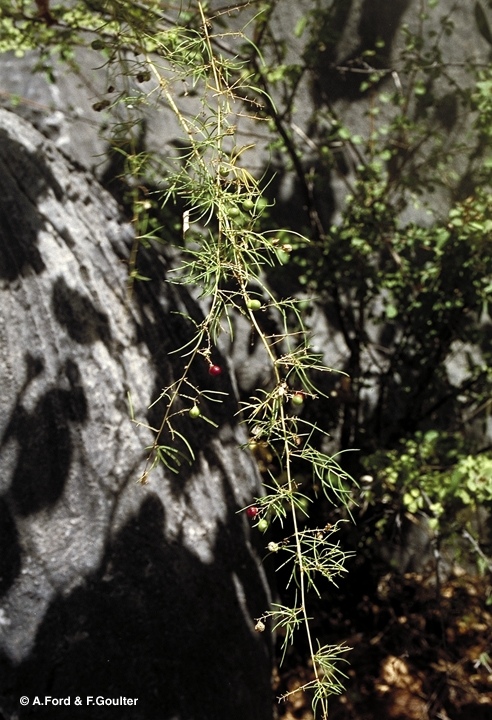Australian Tropical Rainforest Plants - Online edition
Asparagus racemosus Willd.




Willdenow, C.L. von (1799) Sp. Pl. 2: 152. Type: India, herb Willdenow; holo: B. Fide A. A. Obermeyer, S. African J. Bot. 2: 243 - 244 (1983.
Asparagus Fern; Native Asparagus Fern
Usually grows as a vine but can also flower and fruit as a shrub. A slender vine not exceeding a stem diameter of 2 cm.
True leaves absent. Cladodes, +/- triangular in transverse section, each about 15-19 x 0.2-0.5 mm, glabrous, longitudinally grooved. Midrib not visible. Twigs often armed with curved spines about 1-5 mm long. Cladodes produced in whorls opposite, or alternately on the twigs.
The first appendages produced on the stem of the seedling look like cataphylls and although they lack chlorophyll they are probably the first true leaves and are about 2-2.5 mm long. The first green appendages are simple linear cladodes about 1.5 cm long. The seedling subsequently produces branched cladodes in the axils of the simple cladodes and at other places and the whole structure soon becomes complex. Seed germination time 206 days.
An introduced species in WA, NT, CYP, NEQ, CEQ and southwards as far as south-eastern Queensland. Altitudinal range in northern Australia from near sea level to 900 m. Grows in a variety of habitats including open forest but probably most frequently encountered in monsoon forest and vine thickets. Also occurs in Asia and Malesia.
An attractive plant similar to Asparagus plumosus that is now coming into cultivation.
This species may have medicinal properties.
In India the root of this plant has been used as a tonic and diuretic, and for stimulating milk in nursing mothers. It had also some reputation as an ingredient of an aphrodisiac, and of a fertility drug for women. Cribb (1981).





